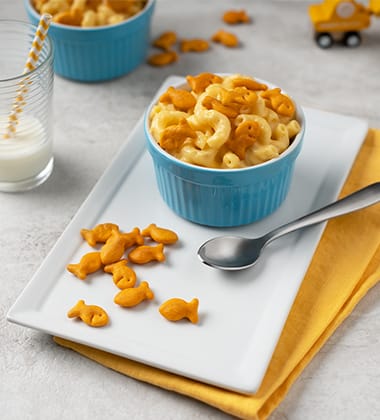The fascination with nostalgia—or, in some cases, “newstalgia,” which refers to the blending of new and old elements—has been growing for the past few years and can be seen across many different fields, from furniture and interior design to fashion and entertainment. And the food industry is no different.
Nostalgic comfort foods, such as macaroni and cheese, shepherd’s pie, and soups, are popular with consumers, growing 20% in menu mentions over the past year.1 That growth should come as no surprise, as smell and taste are generally thought to be two of the strongest triggers of nostalgia2, and memories of favorite dishes from one’s past can provoke strong emotional responses.3
The reason for the popularity of nostalgic food varies from one age group to another. Older individuals, for example, look for items that remind them of happier times from their childhood, while younger people want to share the same experiences of their family or the cultural backgrounds of friends.
Whether you’re looking to refresh your classic offerings or put a new twist on favorites, get inspired by these tips.
Tip #1: Consider Generational Differences
The nostalgia trend cuts across all generations. A survey conducted by Symrise, a German producer of flavors and fragrances, revealed that 70% of people over 65 years old cherished things that reminded them of the past, while 76% of individuals between the ages of 22 and 55 felt the same way.4
Soups and stews, casseroles, meat loaf, deli products, and even certain snacks and beverages all spark memories of days gone by, particularly among older members of the baby boomer generation.5 These classics also can be a way to attract new customers, many of whom may be experiencing some of these foods for the first time.6
The driving force behind the nostalgia, however, differs slightly from group to group. Millennials, for example, harken back to the ’90s when they were kids and unencumbered by the challenges of adulthood. Gen Zers, on the other hand, are looking to share in the happy experiences of other people’s lives without having to deal with all the negative aspects of those times.7
Evoking those food memories is key, according to Campbell’s Foodservice Executive Chef Gerald Drummond. “Craveable foods are often nostalgic,” he said. “What is craveable for me is my mom’s chicken and dumplings. Why? Because it invokes that food memory of going back home and having that dish that makes me feel comfortable.”
It’s possible to combine the interests of different age groups in one dish. Some classic recipes that could cross generational lines include Cheesy Mac Topped with Goldfish® Cheddar Crackers and Tuna Noodle Casserole Made With Campbell’s® Healthy Request® Cream of Mushroom Soup.
Tip #2: Put a New Twist on Familiar Items
Consumers love to see older items get a second chance, even if that means making some changes to the original. Taco Bell, for example, teamed with ice cream maker Salt & Straw to create the Chocolate Taco, the fast-food chain’s version of the Choco Taco, a popular ice cream truck treat that was discontinued in 2022. Tyler Malek, Salt & Straw’s co-founder and head chef, says the Chocolate Taco offers “a bit of a gourmet twist” and is slightly spiced and uses more buttermilk than the original treat.8

Also consider using different ingredients, flavors, and spices to give nostalgic dishes an elevated profile. For example, instead of plain old macaroni and cheese, try recipes such as Chicken & Poblano Mac & Cheese made with Campbell’s® Culinary Reserve Roasted Poblano & White Cheddar Soup or Lobster Mac & Cheese made with Campbell’s® Culinary Reserve Lobster Bisque with Sherry.
Another way to update familiar items is to incorporate global flavors. For example, “We recently developed a Thai Walking Nacho using a Thai Green Curry Sauce as the base and adding kettle chips, chicken, red chile, cilantro, and a squeeze of lime,” said Campbell’s Foodservice Executive Chef Gerald Drummond. “This item has those Thai flavors and relates to the trends of global comfort and nostalgia.”
That same soup can be used to give the classic comfort dish of wings an update, according to Chef Drummond. “Grilling the wings after marinating them in a Thai Green Curry Soup gives them a great depth of flavor, and it hits that comfort food trend, which is perfect for bar and grill restaurants.”
Whether you call it retro, nostalgic, or “newstalgic,” people clearly want food that reminds them of people and events from their past. Serving up the right food, flavors, and aromas will carry your customers down memory lane to happier times and your business to even more success.
New nostalgia is just one of the biggest food trends of the year. Get inspired by more trends with our Culinary TrendPulse 2024 report.
1 2024 Culinary TrendPulse Report, Campbell’s Foodservice
2 “This Sense Has Made Us the Most Nostalgic in Lockdown,” eat.drink.sleep, April 27, 2021
3 Sherrell, Zia, “Why Do You Experience Food Nostalgia?” Healthnews, February 5, 2024
4 “The New Nostalgia of Foods,” Symrise, May 10, 2022
5 Kelly, Karen, “10 Seriously Boomer Foods That Boomers Love According to the Internet,” Seasonal Cravings, September 21, 2023
6 2024 Food Trends Report, Datassential
7 Daniels, Lauren, “Back to the Flavors of Nostalgia,” The Tastewise Blog, February 15, 2023
8 O’Hara, Katy, “The Choco Taco Is Finally Coming Back, but Only at Taco Bell,” Allrecipes, February 22, 2024









































